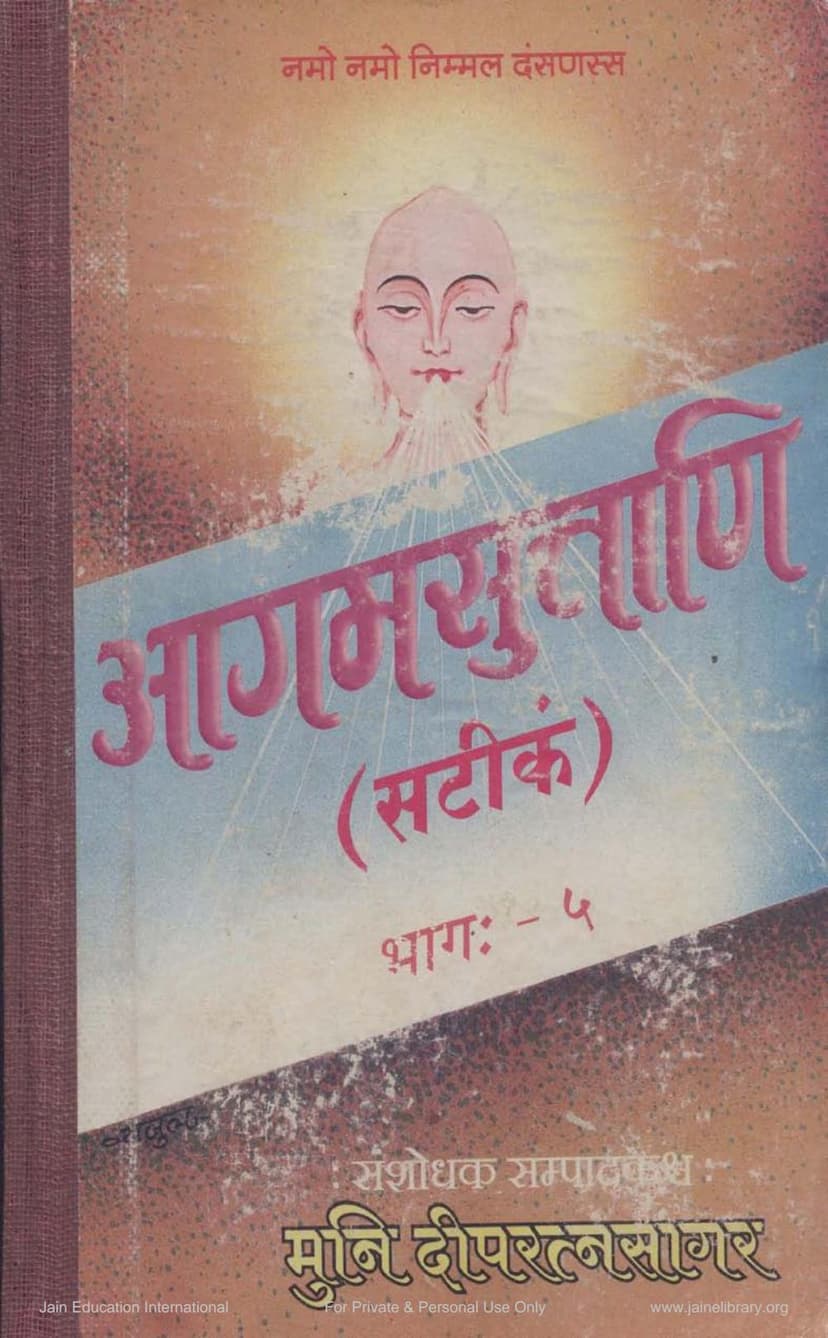Agam Sutra Satik 05 Bhagavati AngSutra 05
Added to library: September 1, 2025

Summary
The provided text is a comprehensive summary of the Jain Agam Sutra, specifically the Bhagavati Anga Sutra (Part 5), as translated into English. It covers the introductory sections, dedications, publisher information, and a detailed table of contents spanning 10 centuries (Shataka) and 10 chapters (Uddeshak) each. The summary delves into the philosophical and ethical underpinnings of Jainism as presented in the Bhagavati Sutra, covering topics such as:
Key Jain Philosophical Concepts:
- The Bhagavati Sutra: Referred to as the fifth Anga and also known as Vyakhya Prajnapti Anga Sutra, it's a fundamental text for understanding Jain doctrine.
- Pancha Paramesthi Namaskara: The text begins with a detailed exposition of the significance and meaning of the five supreme beings in Jainism (Arhats, Siddhas, Acharyas, Upadhyayas, Sadhus), emphasizing the importance of devotion and respect towards them.
- Mangala (Auspiciousness): It discusses the concept of inner purity (Bhava Mangala) as superior to external auspicious rituals.
- Karma: The sutra extensively discusses the nature of karma, its bondage, stages of transformation (like changing duration, intensity, form), and eventual liberation through Nirjara. Various classifications of karma and their effects are explained.
- Soul (Jiva): The text touches upon the soul's nature, its potential for liberation, and its different states of existence (e.g., in hellish realms, as animals, humans, or celestial beings).
- Jiva and Ajiva: It elaborates on the distinction between living beings (Jiva) and non-living substances (Ajiva), a core tenet of Jainism.
- Pudgala: The nature of matter (Pudgala) and its permutations, including the concept of atoms and aggregates, is discussed.
- Time (Kala): The text explores the concept of time, its various divisions, and its influence on existence.
- Space (Akasha): The nature of space, including its infinite extent and role in housing other substances, is detailed.
- Naya (Standpoints): The text highlights the importance of different philosophical standpoints (Naya) like Dravya Naya (substance) and Paryaya Naya (mode) in understanding reality.
- Non-violence (Ahimsa): While not explicitly detailed in the provided summary of the table of contents, the overarching Jain philosophy of Ahimsa is implied throughout the discussion of actions and their karmic consequences.
Structure and Content:
The detailed table of contents reveals the vast scope of the Bhagavati Sutra, divided into 10 centuries (Shataka), each further divided into 10 chapters (Uddeshak). The topics covered are incredibly diverse, ranging from:
- Cosmology and Geography: Descriptions of hellish realms (Narakas), different types of heavens (Devas), their lifespans, populations, and the structure of the universe (Lokakasha, Alokakasha, mountains like Meru).
- Jain Practices and Ethics: Discussions on austerities (Tapas), vows (Virati), conduct, the importance of the Jain path (Marga), and the principles guiding monks (Anagara) and nuns.
- The Nature of Existence: It addresses the fundamental questions about life, death, and rebirth, the causes of suffering, and the path to liberation.
- The Jina's Powers and Attributes: Descriptions of the omniscient and omnipotent nature of the Jinas, their miraculous abilities (Vikurvana), and their teachings.
- Specific Categories of Beings: Detailed discussions on different types of beings, including those in hellish realms, celestial beings (Devas of various classes), plants (Sthavara), and sentient beings (Tiras and Manushyas).
- The Five Senses and Their Role: The text explains how beings interact with the world through their senses and how sensory experiences influence karmic accumulation.
- The Process of Liberation (Moksha): The ultimate goal of Jainism, liberation from the cycle of birth and death, is implicitly or explicitly discussed through the lens of karma and spiritual practice.
Commentary and Publication:
The text is presented as "Agam Sutra Satik," indicating it includes a commentary. The "Satik" designation and the mention of "Abhaydev Suri virachita vritti" (commentary by Abhaydev Suri) suggest a scholarly and traditional presentation of the text. The publisher is "Agam Shrut Prakashan," and the catalog link points to "jainqq.org," a known repository for Jain literature. The dedication to various spiritual figures highlights the reverence and lineage associated with this publication.
Overall Significance:
The Bhagavati Sutra, as detailed in this summary, is a treasure trove of Jain knowledge, offering deep insights into the Jain worldview, cosmology, ethics, and the path to spiritual liberation. Its comprehensive coverage of diverse topics makes it a vital text for Jain scholars and practitioners seeking to understand the intricacies of their faith.